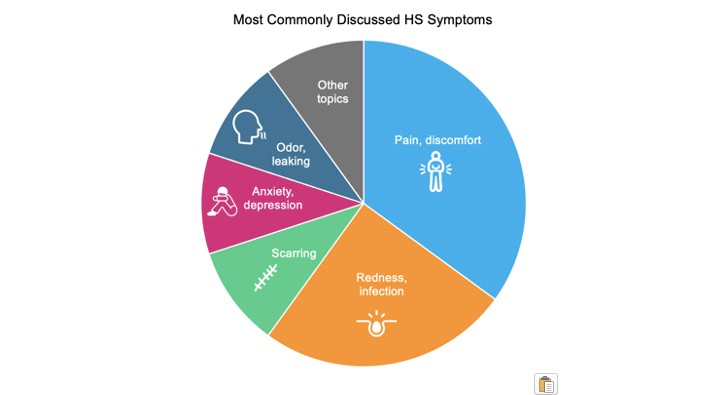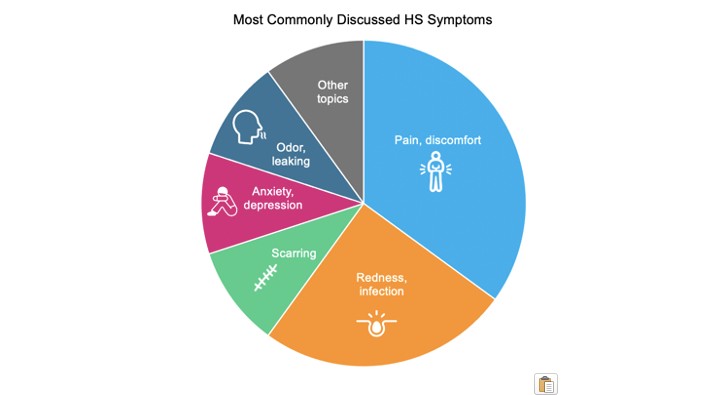 February 11, 2021
February 11, 2021
The Patient POV: The Real-World Experience of Living with Hidradenitis Suppurativa (HS)
As key opinion leaders in the field of Hidradenitis Suppurativa gather virtually this week at the European Hidradenitis Suppurativa Foundation 2021 meeting, the unmet needs of patients living with HS are top of mind. Research conducted among members of myHSteam, our social network for people facing hidradenitis suppurativa (HS), highlights the enormous burden of this chronic condition and reveals many opportunities for better serving patients. The research, featured at the recent Symposium on Hidradenitis Suppurativa Advances (SHSA), was done in partnership with UCB with the goal of better understanding patients’ real-world experiences with diagnosis, treatment, and living with the disease.
Three insights from the research stood out to me that are so common across autoimmune conditions.
1) The path to HS diagnosis is often long and complicated.
HS is a skin condition that causes small bumps to form under the skin. The bumps can break open, and tunnels can form under the skin. The condition mostly affects areas where the skin rubs together, such as the armpits, groin, buttocks and breasts. It is often quite painful. Many people suffer for years before accurate diagnosis – an unfortunate and fairly common occurrence that exacerbates symptoms and delays treatment.
Based on the conversations within our social network, this happens for a variety of reasons. Some people initially think the bumps are normal, or else they are embarrassed to ask a doctor about them. In some cases, a primary care physician, ER doc, or even sometimes a dermatologist, treats the area when a bump becomes infected – but doesn’t pursue the underlying cause – or worse – tells the patient that they need to go home and practice better hygiene to avoid these bumps from forming. We hear from many members of myHSteam that their bumps were initially misdiagnosed as cysts. As symptoms worsen, people are often referred to a specialist. Ultimately, it is often a dermatologist who is well versed in HS who is able to accurately diagnose the condition and recommend treatment. This journey, however, can take years – creating both physical and emotional strain.
2) HS symptoms take a significant toll on quality of life.
Analysis of common themes in myHSteam conversations reveals that pain is the symptom that most plagues people living with this disease. Other symptoms often discussed include redness/infection, scarring, odor/smell, and anxiety and depression.
Dealing with this daily reality, takes a significant toll on quality of life. Members of myHSteam provide each other with emotional support and talk about how HS can make it difficult to walk, sleep and work.
3) Current treatments aren’t meeting the needs of HS patients.
Surgeries and antibiotics (such as doxycycline and clindamycin) are the most commonly discussed ways to treat HS. Other treatments to help with HS symptoms that members talk about include steroids, the biologic Humira (adalimumab), birth control pills/IUD, and even the diabetes medication, Metformin. Conversations among members indicate they are still seeking treatments that work better, work more consistently, and last for the long haul. Many of the available options are short-term fixes. Antibiotics only work for limited periods of time. Biologics can be effective, but there currently are limited options. Doctors infrequently prescribe biologics for HS. In addition, members have mixed experiences with them. While surgery may be effective, it does not prevent flares in other areas of the body. It also, of course, can be invasive and requires extensive recovery.
The bottom line is that people living with HS need more help getting to diagnosis and managing their condition earlier on. A big part of improving the real-world experience of living with this disease is empowering patients with educational information that helps them more effectively advocate for their health, in partnership with their doctors. That’s why we teamed with UCB to create the HS Resource Center, which helps people identify early symptoms, understand the basics on HS, talk with their doctor about it, and be proactive in managing their symptoms. The feedback has been consistently positive, and we continue to see significant growth in the community – now with 18,000 registered members and growing.
As always, I’m interested in hearing about what you’re seeing work well in patient engagement and patient education. Please share thoughts here or send me a note at [email protected].




